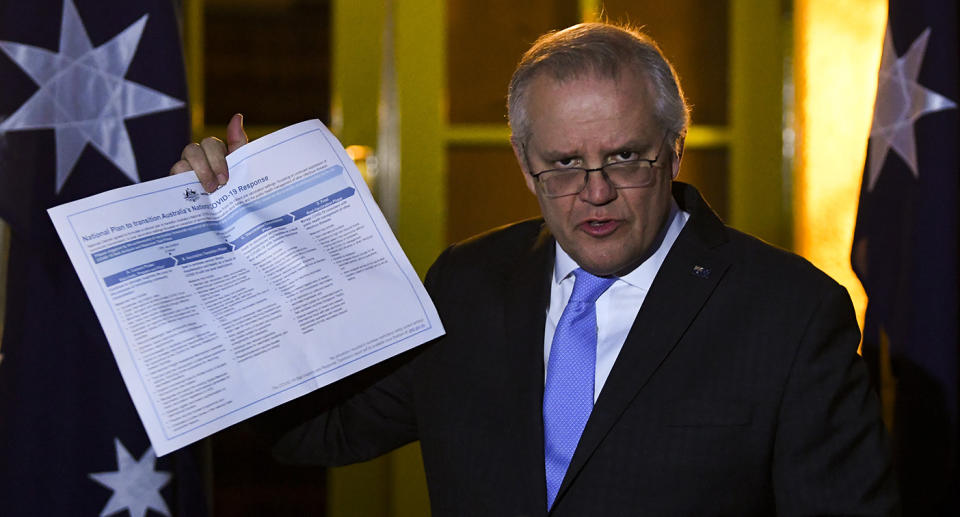National Cabinet Statement – July 30, 2021

The National Cabinet met today to discuss Australia’s COVID-19 response, recent outbreaks of COVID-19 and the Australian COVID-19 Vaccine Strategy.
National Cabinet continues to work together to address issues and find solutions for the health and economic consequences of COVID-19.
Since the beginning of the pandemic there have been 33,909 confirmed cases in Australia and, sadly, 923 people have died. More than 24.8 million tests have been undertaken in Australia. Testing has increased nationally over recent days with 1,209,935 million tests reported in the past 7 days.
Globally there have been over 196.5 million cases and sadly over 4.1 million deaths, with 660,253 new cases and 11,538 deaths reported in the last 24 hours. The COVID-19 pandemic continues to surge in many countries around the world.
Australia’s COVID-19 vaccine roll out continues to expand. To date 12,005,978 doses of COVID-19 vaccines have been administered in Australia, including a record 210,742 in the previous 24 hours.
In the previous 7 days, more than 1,154,985 vaccines have been administered in Australia. More than 39.9 per cent of the Australian population aged 16 years and over have now had a first dose of a COVID-19 vaccine, including over 64.6 per cent of over 50 year olds and over 78.5 per cent of over 70 year olds. More than 18.2 per cent of Australians aged 16 years and over are fully vaccinated including more than 25.2 per cent of over 50 year olds and more than 40.5 per cent of Australians over 70 years of age.
Acting Chief Medical Officer Professor Michael Kidd provided an update on current outbreaks of COVID-19.
Lieutenant General John Frewen, Coordinator-General of Operation COVID Shield, provided a briefing on the vaccination program, which continues to expand significantly.
National Cabinet received a detailed briefing from the Director of Doherty Epidemiology, Professor Jodie McVernon on modelling of COVID-19 infections and vaccinations to define target levels of transition to Phase B and Phase C of the four step National Plan to Transition Australia’s COVID-19 Response, taking into account COVID-19 transmission, severity and vaccine effectiveness of the delta variant.
The modelling has informed an updated four step National Plan to Transition Australia’s COVID-19 Response by COVID-19 Risk Analysis and Response Taskforce (Taskforce), led by the Secretary of the Commonwealth Department of Prime Minister and Cabinet, Mr Phil Gaetjens, and the Commonwealth Treasury economic impact analysis of COVID-19 transitions. Analysis is being coordinated with Commonwealth, state and territory Treasuries, Health Departments and First Secretaries Departments.
All leaders reiterated the importance of Australians, especially those in vulnerable groups, to get a COVID-19 vaccination. Both the AstraZeneca and Pfizer COVID-19 vaccines are registered for use in Australia and are proven to be effective in preventing serious illness and death, as well as limiting transmission.
National Cabinet agreed to meet next on Friday, 6 August 2021.
National Plan to Transition Australia’s National COVID-19 Response
The National Cabinet agreed in-principle to an updated four-step National Plan to transition Australia’s National COVID-19 Response (National Plan) taking into account the Doherty Institute COVID-19 modelling and the Commonwealth Department of Treasury economic analysis.
The National Plan charts the way back.
The National Plan provides a graduated pathway to transition Australia’s COVID-19 response from its current pre-vaccination settings focused on continued suppression of community transmission, to post-vaccination settings focused on prevention of serious illness and fatalities, whereby the public health management of COVID-19 is consistent with other infectious diseases.
The National Plan sets out four phases to effectuate this transition. Each phase will be triggered by the achievement of vaccination thresholds of both the nation, and the individual state or territory expressed as a percentage of the eligible population (16+), based on the scientific and economic modelling conducted for the COVID-19 Risk Analysis and Response Taskforce.
The updates agreed in-principle today by the National Cabinet are the Vaccination thresholds to move to Phase B and Phase C. The National Cabinet will commission further detailed modelling over the coming months to update and refine the National Plan as required.
A sub-group of National Cabinet consisting of Victoria, Tasmania and the Northern Territory will also prepare options on how restrictions can be eased for vaccinated Australians in Phase B.
Phase A. Vaccinate, Prepare and Pilot (Current Phase)
Australia will continue to strongly suppress the virus for the purpose of minimising community transmission. Measures may include accelerating vaccination rates, closing international borders to keep COVID-19 out, and early, stringent and short lockdowns if outbreaks occur.
Phase B. Vaccination Transition Phase (~70% of adult population fully vaccinated)
In this phase, Australia will seek to minimise serious illness, hospitalisations and fatalities as a result of COVID-19 with low-level restrictions. Measures may include maintaining high vaccination rates, encouraging uptake through incentives and other measures, minimising cases in the community through ongoing low-level restrictions and effective track and trace, and with lockdowns unlikely but possible and targeted.
Phase C. Vaccination Consolidation Phase (≥80% of adult population fully vaccinated)
In Phase C, Australia will seek to minimise serious illness, hospitalisations and fatalities as a result of COVID-19 with baseline restrictions. Measures may include maximising vaccination coverage, minimum ongoing baseline restrictions adjusted to minimise cases without lockdowns, and highly targeted lockdowns only.
Short URL: https://indiandownunder.com.au/?p=16728
